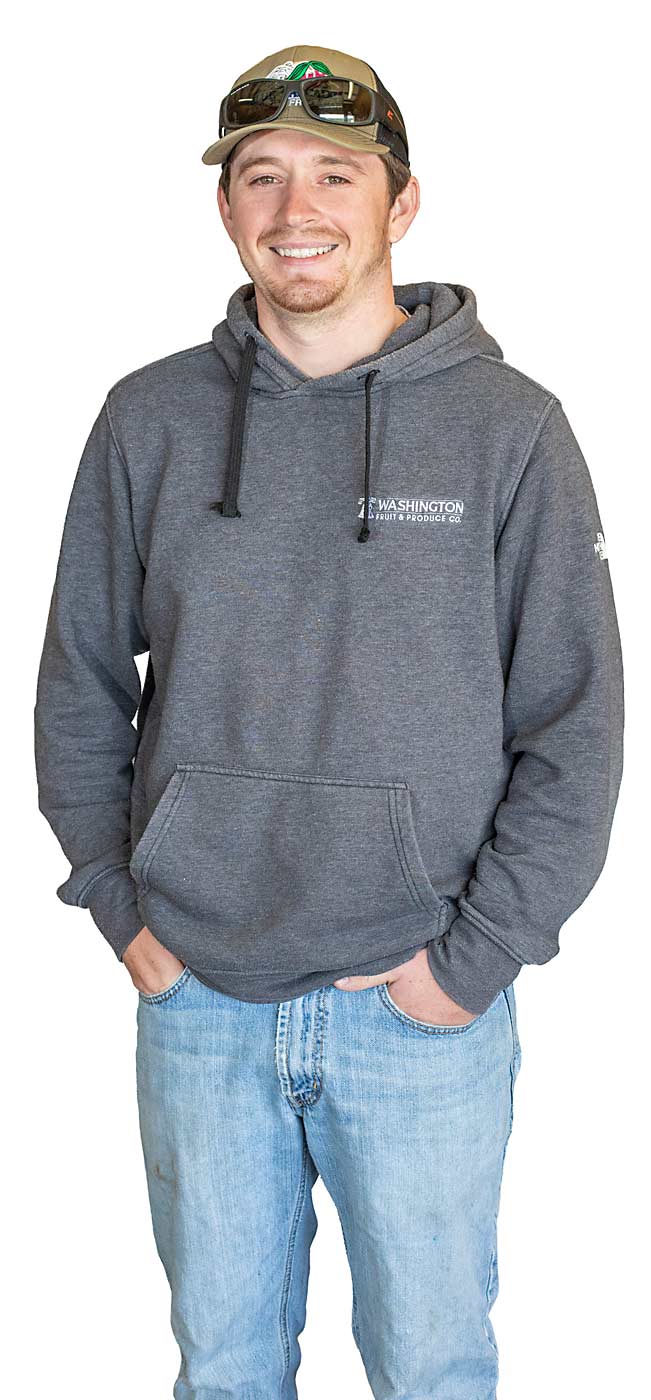family background/ Connor graduated from Wenatchee Valley College with a degree in sustainable agriculture. He’s the son of Sheryl and Mike Duim.
age/23
grower/Zillah, Washington
crops/apples, cherries and grapes
business/Cherry Ridge Orchards

How did you get your start?
The first thing I can remember growing up was running around on the forklift with Dad, loading up cherry bins into the truck and taking them to the warehouse.
It kind of lit a fire under me that I really wanted to go into farming. When I was in high school, I worked in the orchard and vineyard department of an orchard supply store. We’d bid out materials for trellising — basically supplying farms with about everything they needed for an orchard or vineyard system.
I really enjoyed doing that early on, before I made the decision, when I was about 20 years, old to come back to the farm and work with my dad and focus on making the farm sustainable financially so we’re not just farming year-to-year.
How are you planning to do that?
I wanted to try to get some new plantings in the ground with desirable varieties, boost production and still keep that balance between apples and cherries. For instance, I don’t want to get too heavy on cherries or too heavy on apples; they are complementary crops.
You may have a few years where apples aren’t doing so hot, but you’re making a little money on cherries and that helps supplement what you’re losing on apples. Because of that, we’re trying to keep about the same amount of apples and cherries in the ground.
Our Concords are on a piece of dirt that’s low, flat and gets really cold in the spring, and it’s not ideal for apples or cherries. The best crop to plant there was Concords, otherwise that ground would just be idle, and we’d just be paying property taxes on it without recouping any investment. We’re also using our grape equipment to do custom harvest, picking other people’s Concords.
Concords are a pretty low-maintenance commodity for us. We prune them, water them, spray the weeds — that’s basically all we need to put into them. During the summer months when we’re paying attention to our apple and cherry crops, we can let the grapes grow and be a profitable source for us, where nothing else could be in that dirt and be profitable.
Are you considering orchard improvements?
Right now, we have some apple varieties that’ve been in the ground since the ’80s, and we have some blocks that are 30 years old and still cranking out fruit. For us, it wouldn’t be economical to rip those out and plant something else, because they are making money and producing really good quality apples. We have a few cherry blocks, on the other hand, that are about 23 years old, and they’re not producing the tonnage we need to make a profit.
I’m thinking about what I can plant in that piece of dirt, what row spacing, tree spacing and what rootstock I can plant to make it economical. What is the best variety for us to plant — especially with apples — because it changes so much. I’ve got a Red block that’s not producing what we want, and I’m thinking about ripping it out and planting cherries.
What cherry do I want to plant, what rootstock do I put on it? Whatever we do will be a big decision. If we put $30,000 to $40,000 an acre into a new planting, then we want to get it right. We’ve got to be methodical, thinking of every aspect of what we’re going to plant before we go and spend money putting it in the ground.
What have you learned from past plantings?
When my grandfather and dad started planting cherries, back in the mid-’90s, Colt was the rootstock they used. It’s a big, aggressive rootstock that grows a huge tree. It’s not the greatest cropping rootstock, however.
Later on, we planted some Mazzard, and it seemed to work well. Then Gisela 6 came out and he thought because it was a smaller rootstock that crops well, we’d plant some 15 acres of cherries on that. Since we’re higher up in the Yakima Valley, where a single shovel dig will hit rocks, we found out real quick that Gi.6 did not work very well out here.
It’s not an aggressive enough rootstock to get the nutrients the tree needs in rocky land. We tried it, found out it doesn’t work, and learned that the smallest rootstock we can pretty much use is maybe a Gi.12 and Mazzard. Knowing your soil and what it can do will really help you decide what to plant on a given location.
What would you tell young growers about planning?
Whether it’s 10 years or 20 years down the road, the challenges and costs of labor shortages will only increase. Using more automation will be what’s going to happen. When looking at all of the new orchards being put in, they are high-density, V-trellis or vertical.
Some growers are getting ready for a future with mechanical harvesting where machines are working in trellis systems, not free-standing trees. Even right now with a V-trellis system, a grower is making tasks like pruning that much easier to do while working on a platform.
What I’d tell other younger growers is that you need to be mindful that we’re going into a future with automation. When you go into planning a new planting, you need to keep that in mind.
—TJ Mullinax






Leave A Comment